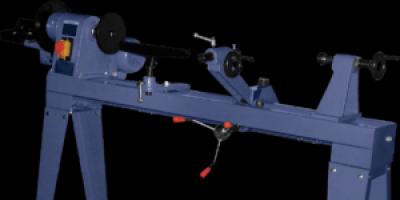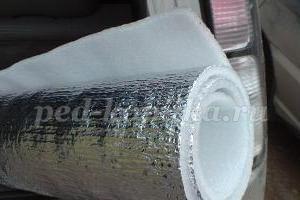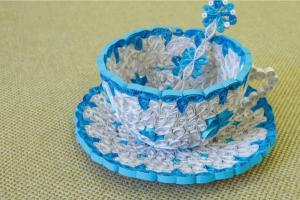A deep-well pump is a powerful installation capable of regularly pumping water from the deepest sources. In everyday life, such a unit can be used both for a well and for a well. Below we will consider in detail the design and operating principle of the device, as well as the features of its selection and connection.
The design of a deep well pump - design features of the unit
Household design deep well pumps may be different. It all depends on the type of motor, operating principle and parameters of the units. Each submersible deep-well pump consists of two main parts - a built-in or external motor, and a multi-stage pump unit.
The built-in motor is usually located at the bottom of the pump - this protects the motor from contact with water. Above the engine there is a drive shaft of the unit, wheel guides and special blade-shaped outlets. 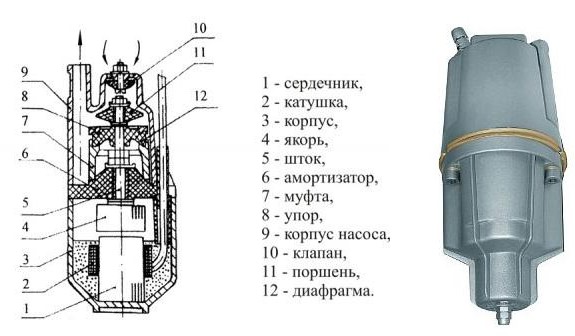
Depending on the type of deep-well borehole pump, it may be equipped with additional spare parts. To device vibration pump, in addition to the motor and shaft, a special glass and a vibrator are also included, creating the necessary for work high pressure. The vibrator itself consists of an armature, adjusting washers and a rubber shock absorber. The latter is compressed during pump operation, thereby creating the conditions necessary for water intake. All elements of the vibration pump are located in a durable housing.
Another type of deep water pumps is centrifugal units, which are a little more complex in design and more durable in operation. It is because of this that most buyers prefer this particular submersible pumping equipment. The main role in such a device is played by the blade outlet attached to the engine of the unit. Pumps of this type almost do not overheat due to the fact that the bearings inside its structure are cooled through contact with the pumped water. Most centrifugal pumps are equipped with built-in automation that protects the equipment from dry running and voltage surges in the home electrical network. 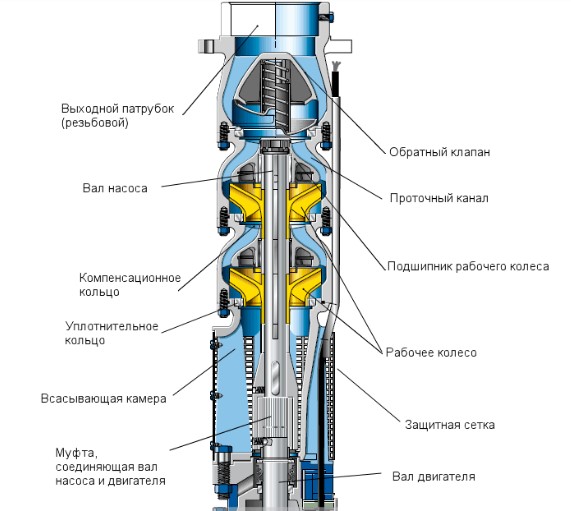
All elements of the centrifugal pump are located in a durable sealed housing made of of stainless steel.
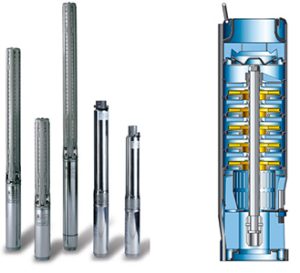 Each type of equipment works differently. The principle of operation is largely influenced by the elements with which the deep-well pump is equipped. The vibration unit performs its functions by moving the piston. When electricity is supplied, an electromagnetic field is created inside the device, which attracts the vibrator - this drives the pump piston. At the same time, a discharged pressure is generated in the working chambers of the unit, which pushes water into the free space of the chambers. Using the same principle, water passes through the channels into the pipeline.
Each type of equipment works differently. The principle of operation is largely influenced by the elements with which the deep-well pump is equipped. The vibration unit performs its functions by moving the piston. When electricity is supplied, an electromagnetic field is created inside the device, which attracts the vibrator - this drives the pump piston. At the same time, a discharged pressure is generated in the working chambers of the unit, which pushes water into the free space of the chambers. Using the same principle, water passes through the channels into the pipeline.
The operating principle of a centrifugal deep-well water pump is based on the rotation of the impeller. In this case, a centrifugal force is created along the perimeter of the working blades, pushing water from the suction pipe into the pressure channel, and then into the pipeline. Another type of equipment works on the same principle - a screw pump.
How to choose a deep-well pump for a well - we decide for ourselves
To choose a pump that can lift water from depth, you must adhere to certain rules. Among other things, you will need to study the technical characteristics of the unit. The most important parameters include: 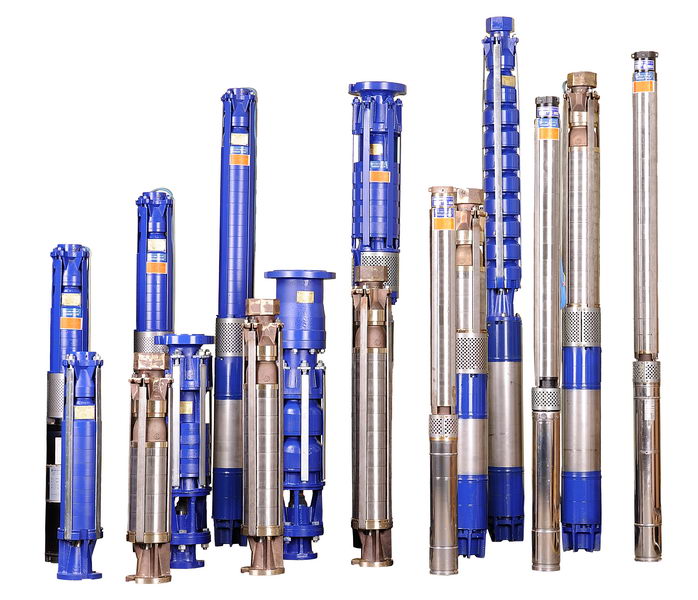
- Pump power - deep-well devices are already quite powerful devices in themselves. As a rule, this equipment indicator does not fall below 1.5 kW. This is quite enough to pump water from sources up to 30 m deep;
- Productivity - when calculating this indicator, you need to take into account that a family of 4 people on average consumes about 200 liters. water per day. Therefore, it is better to buy a pump capable of pumping at least 50 l/min. This productivity will allow you to stock up on water for various household needs and watering the garden;
- Availability of built-in protection - the pump must have a float switch, pressure switch or water flow switch. These devices will significantly extend the life of the unit;
- Size of the water source - each deep water pump has its own dimensions and weight. If the diameter of the well is not large, then the unit must be of appropriate dimensions so that the owner can safely immerse it in water;
- Pump pressure - when calculating, it is necessary to take into account that 1 meter vertically is equal to 10 meters horizontally. You need to add another 30 meters to the pressure indicators indicated in the pump passport. Thus, if the well depth is 40 meters, then the pressure created by the unit should be at least 70–80 m.
The method of cooling the device is also of great importance. It is best to buy pumps whose motors are cooled by working fluid. Such devices do not require special care or frequent checks, as they operate almost completely autonomously.
Having purchased a suitable pump, you can begin arranging a water supply from a water source. This will require pipes through which water from the well will flow into the house. The diameter of the pipes should be 25–32 mm. Experts advise buying polymer products, as they do not corrode and are easy to bend. Further, during the work process, the pipes will be installed in the soil to a depth of 30–50 cm. To arrange water with your own hands, you will also need a septic tank. To make it easier to maintain, you will need to purchase a drainage pump.
Having prepared everything you need, you can start working. The algorithm of actions is as follows:
- First of all, you need to equip the pipe coming out of the well with a head;
- Next, you need to install the caisson. To do this, you will need to dig a hole next to the well and place a plastic container inside it;
- After this, you need to install the pump in the well. To do this, you need to pull a hose onto its nozzle and secure it securely with a metal clamp. After this, the hose, cable and safety rope are tied with electrical tape in increments of 1.2 m. Then the pump body is tied with a steel cable, and the unit itself is lowered into the water. During installation, the device should not swing, otherwise hitting the wall will cause pump malfunctions;
- Next, you need to connect the hose to the underground pipes. All joints must be treated with sealant and tied with FUM tape;
- Before burying dug trenches, the water supply should be checked. To do this, you need to start the engine for a while and observe the amount of water flowing from the pipes. If the pump performance does not decrease, you can dig trenches.
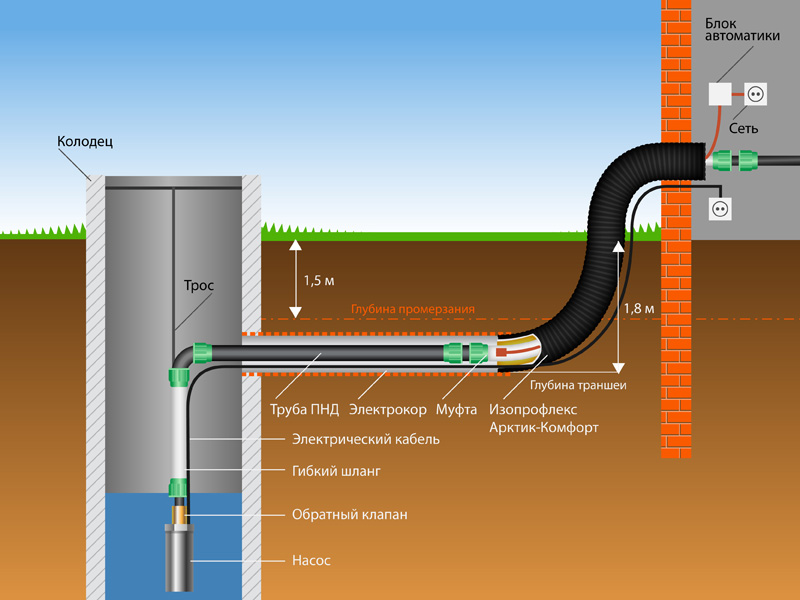
It is very important not to damage the unit while lowering it into the well. This must be done very slowly and carefully. Otherwise, an expensive repair of the device may be required, or a complete replacement of the deep-well pump.
Owners of country houses and private houses are often interested in how to properly connect a pump and a hydraulic accumulator into one whole system. First of all, this requires carefully studying the equipment connection diagram. 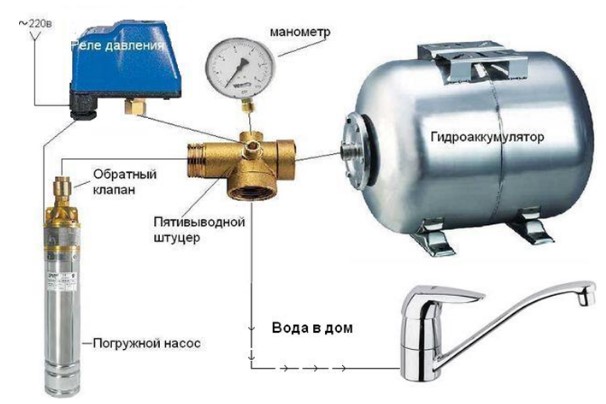
The “pump-check valve-hydraulic accumulator-pressure sensor” principle is the simplest and most durable. Such a scheme rarely requires repairs, it does not require maintenance or frequent checks, and operates completely autonomously. The essence of this scheme is that the pump pumps water to a system that is connected to a hydraulic accumulator. The pressure sensor in the design is responsible for the proper operation of the pump.
If most beginners do not have any questions about the principle of operation of the hydraulic accumulator, then in practice everything turns out to be much more complicated with installation and connection to the water supply system.
Essentially, a hydraulic accumulator is a reservoir filled with water. Despite simple design, he plays enough important role in the water supply system of a private house. In this regard, it is necessary to mount the device extremely carefully, trying to eliminate any possibility of extraneous noise and vibration.
To securely fasten the tank to the floor surface, you should use a special rod mechanism, which is equipped with thick rubber pads that dampen vibration. The hydraulic accumulator is connected to the pipeline using rubber adapters.
You need to be especially careful with a new tank. Water should get into it weak pressure so that the membrane, which has caked during storage, slowly returns to its normal operating condition. The hydraulic accumulator connected and filled with water is first tested by working under weak pressure. Next, the pressure must be gradually increased until the water supply system begins to operate normally.
Well pumps are devices designed to lift water from great depths. As the name implies, pumps of this type are installed directly into a drilled well, and due to the significant degree of immersion, they received a second name - deep.
Deep pumps for wells are necessary to ensure water supply to private houses, housing and communal services facilities, enterprises, industrial buildings, as well as for irrigation and watering of household plots. A feature of such pumps is their compact size, which allows transporting water even from the narrowest wells, an acceptable level of pressure and long term operation.
The classification of deep-well pumps is extensive: each type has its own characteristics.
Submersible pumping equipment
Used to lift water from any tanks. Unlike other varieties, the submersible pump is placed directly in the water. This indicates the need to use high-quality materials in manufacturing that can effectively resist corrosion.
Based on the principle of operation, units are divided into vibration and centrifugal.
Vibration device class
At the moment they are the most economical option. In addition to their reasonable price, vibration-type pumps are attractive due to their simplicity of design and ease of maintenance.
This type of pumping equipment is devoid of bearings and rotating elements - the most vulnerable parts of any mechanism, requiring constant monitoring of engine operation and lubrication. The absence of rotating parts not only reduces heating of the device, but also prevents premature wear.
Vibration pump is the most economical solution
The principle of operation is simple. It is based on the creation of a magnetic space when electricity passes through a coil. When current touches the coil winding, a magnetic region is formed that draws in a core connected to a rod, which in turn is connected to a rubber diaphragm.
The diaphragm bends and creates a reduced pressure in the pump chamber. Water enters the chamber, then it’s the turn of the springs. The diaphragm returns to its original position, creating overpressure, closing the valve. Water rushes to the consumer through the outlet pipe.
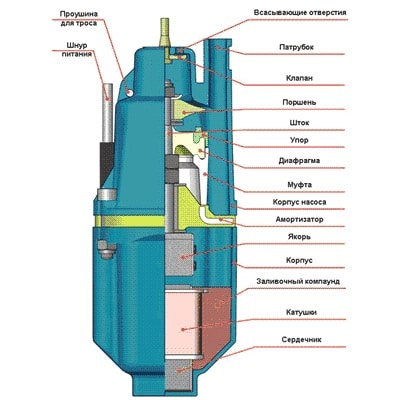
A submersible vibration pump is an ideal device for pumping water from various containers, watering vegetable gardens and orchards, for pumping water out of flooded basements and organizing water supply for industrial and domestic buildings.
Centrifugal pumps for wells
A common class of equipment that can be used to pump different liquids: cold and hot water, acid and oil solutions.
A centrifugal pump consists of a motor on the shaft of which an impeller with holes for outflow and water supply is attached. The principle of operation is based on the transfer of energy from a rotating wheel to the liquid that is located between the blades. Centrifugal force sucks liquid into the housing and creates a pressure difference. The pump operates continuously, supplying water through the outlet pipe.
![]()
Centrifugal pump - the ability to create high pressure with standard performance
Centrifugal pumps are either self-priming or normal-priming, each of which is divided into single-stage and multi-stage.
Self-priming pumps differ in the horizontal arrangement of the body. They start working when the suction pipe is completely filled with air. A normal suction pump, on the contrary, must be filled with water before switching on.
Multistage ones differ from single-stage ones in their ability to develop high pressure, while the performance remains the same.
Surface pumps for wells
Such equipment will make it easy to provide your cottage or country house with drinking water. It is indispensable for irrigating household areas.
It is important! Surface pumps are not designed to pump even minimally contaminated water.
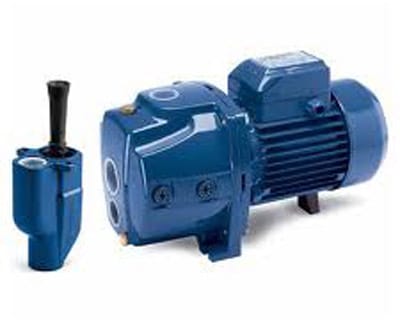
The surface pump is not immersed in a well or well; only a flexible hose is inserted into the source
The pump remains on the surface during operation. Only the hose is lowered into the water. The suction depth is 9 meters, but you can additionally purchase ejectors to increase this figure.
Before operation, the surface pump should be filled with water. Models with automatic system startup and shutdown are considered more profitable, because consume little energy, are protected from overheating and pump water much better.
Manually operated units
Pumps are used to supply and transport liquids without abrasive components, as well as media such as alcohol, edible oils, paraffin, and fuel.
It is important! It is unacceptable to use a hand pump to pump ether or carbon dioxide sulfide. The temperature of the pumped solution should not exceed +80 degrees.
A hand pump for a well has a suction height of up to 9 meters (if there is a check valve at the end of the water supply). These pumps are ideal for filling the pipelines of large pumping units before switching on.
The hand pump consists of a body, a cover, a wing, a suction part, a lever, 4 valves and a shaft. The principle of operation is to rotate the wing using a hand lever so that each side participates in the process of suction or displacement, ensuring continuous movement of the liquid.
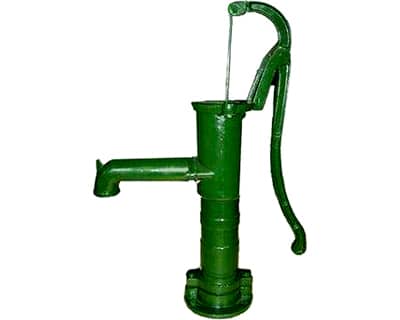
A hand pump pumps liquid with varying degrees of contamination and different densities
Exists a large number of hand pumps, different appearance, technical characteristics and scope of application. Some are designed to work only with oils and fuels, others - with contaminated water.
Which pump is best for a well?
Have you decided to install a pump for a well or well, but don’t know which model is right for you? Probably, the majority, when trying to solve a problem, will first sit down at the computer and try to find an answer on the Internet. Of course, the request “pumps for wells: reviews” may somewhat clarify the difficult situation, but virtual information is clearly not enough to reliably answer the pressing question.
Parameters that determine the choice
So, when choosing a pump, you need to pay attention to some points:
1. Marking the base of the well bottom. This information can be gleaned from the well passport issued by the drilling company.
2. Dynamic water level. An important characteristic reflecting well flow rate. The dynamic level is a segment from the earth's surface to the water surface during pump operation. Debit - maximum amount fluid that the well produces per unit of time.
It is important!
If a significant amount of water remains above the pumping unit after its operation for half an hour, then the flow rate is good.
3. The static water level is the distance from the ground to the water surface. Before taking measurements, the well should not be pumped for some time. We subtract the static level indicator from the depth of the well and obtain the value of the well water column.
4. Pipe diameter.
You can measure these parameters yourself or seek the help of specialists.
Which type of pump should I choose?
If the distance to the water surface is no more than 9 meters, then you can purchase a surface pump. A submersible pump is also suitable, but note that the depth of the reservoir must exceed 1 meter. Otherwise, instead of water, you risk getting silt, sand and air.
The source of the liquid is important. If water is taken from a well for drinking, and from a river for household needs, then it is better to choose a surface pump that can be moved, whereas this will not work with a submersible one.
If the depth is more than 8 meters and the water quality leaves much to be desired, then pay attention to centrifugal pumps. When choosing Special attention pay attention to performance and pressure indicators.
Now that water pumps for wells have been reviewed and the appropriate type of device has been selected, installation can begin.
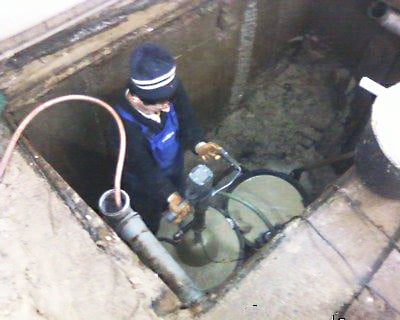
Installing a pump in a caisson built for a water-bearing well
The well pump should be installed 10 meters below the dynamic level. If the equipment is installed at a depth of more than 80 meters, then a pipe of 16 atmospheres is needed, if at a depth of up to 80 - 12.5 atmospheres.
It is important!
Be sure to install a check valve on the pumping unit.
Connect the pump to the water riser pipe through a brass fitting. The transition from the pipe must be metal and have a bushing that prevents the pipe diameter from decreasing due to the tension of the compression fitting.
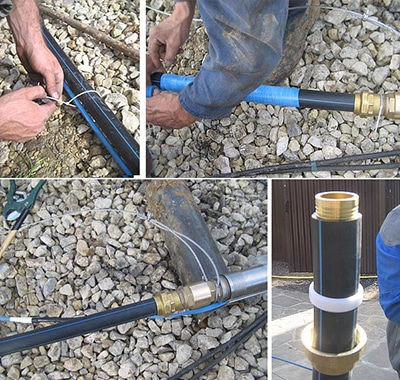
The second end of the pipe must be connected to the outlet of the head using a hammer-in brass fitting. Using a cable coupling, we connect the pump with a conductive cable.
We attach the cable in the water-lifting pipe every 3 meters with plastic clamps.
You need to know this!
Instead of clamps, it is allowed to use electrical tape.
Attach a stainless steel safety cable with a diameter of 5 mm to the head and pump. Do not use ferrous metal or galvanized steel cables. Ready. All that remains is to lower the pump into the well.
Watch the video listing additional equipment for installing a submersible pump in a well and detailed description technological process settings:
Now you know how to install a pump in a well, and you can enjoy the usual amenities even far from city civilization.
Have you decided to start choosing a pump? The following article will help you understand this issue. These devices allow you to fully water plants and pump a lot of water from a well into various containers. Thanks to the information presented, you will be able to better understand the structure and operating principle of these units. The ability to choose wisely best option for your dacha will save your money.
The favorable price for household appliances that work with pumping water makes it possible to purchase them for the conditions of any dacha. Unpretentiousness in operation allows the devices to operate in an aggressive climatic environment, and the simplicity of the mechanism means they do not lose their functions after canning for the winter or in rooms without heating. To learn about the weak points that pumps have and protect them from possible breakdowns, please read the information below.
How do submersible vibration pumps work?
A deep-well pump is a simple device designed to solve everyday problems.A deep-well pump is a simple device designed for household tasks and consists of several elements. The main element that moves the mass of water is force. This is an electromagnetic core in the shape of the letter “P”. Electrical steel, with tightly wound winding, insulated with varnish, cast epoxy resin so as to ensure the safe operation of the device, eliminating the possibility of water entering the core device. The electromagnet itself is firmly held inside the housing, thanks to reliable fixation and cavities occupied by quartz sand, necessary for the cooling wire through sheets of electrical steel.
A rod is attached to a magnet in the shape of the letter “P”. It works with a rubber washer that serves as a shock-absorbing pad. The quality of the gasket affects the performance of the device as a whole. The operating principle of the gasket is as follows. The shock absorber is adjacent to the plastic coupling; it isolates the operation of the pump chamber. The coupling acts as a container for collecting and passing water, isolating the liquid from the electrical mechanism of the unit. A special diaphragm guides and fixes the rod; it is fixed in the inner part of the coupling.
Some manufacturers increase the length of the rod, optimizing the operating principle. This allows you to qualitatively take advantage of the centrifugal force of which submersible units are capable. With this feature of the submersible design, the rod fully protrudes into the coupling chamber. The lugs, which are located in the inner part of the chamber on the rod, improve the conditions for the centrifugal force of the rod. The result is a guaranteed increase in the productivity of the entire system as a whole, because in this case the rod moves less.
The mushroom-shaped rubber inserts you may notice on the pump are called check valves. Through these parts, water seeps into the chamber, but they do not allow liquid to escape, as they are provided as a locking mechanism when squeezed.
Increased elasticity of the check valve is required, which allows you to ignore the accumulated debris in the internal part of the pumping device. The elasticity allows the valve to fit tightly against the walls of the coupling, limiting the stopper. Otherwise, part of the water will be sent back, which will negatively affect the efficiency and speed of operation of the unit.
The rubber piston is in fact a fundamental part of the design; disruption of its operation can cause contamination of the source with small debris. In most cases of failure, the piston itself fails. A similar claim cannot be made about the other parts, since they are more durable, although they are constantly subject to vibrations as the submersible unit operates.
Principle and features of work
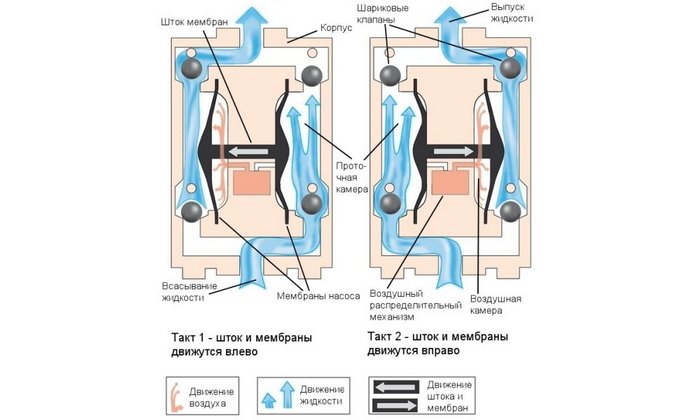
The changing pressure force inside the discharge chamber allows the pump to operate. The reciprocating movements of the rubber piston (or diaphragm, depending on the model) cause rapid flow of water. With a detailed step-by-step examination, the following picture emerges. The unit receiving electricity provokes the appearance on the coil windings. magnetic field. When magnetized, the U-shaped core attracts the vibration part of the unit - the coil, which is located in the discharge chamber.
The resulting impulse influences the piston, which turns inward, and the rod device is then thrown back with the action of check valves. The principle of reciprocating current is determined by the operating conditions of alternating current, alternately arising and disappearing and forming dips without magnetization of the coil. This property allows the coil to be thrown back each time and, when magnetized, repeat the action again. The piston pressing on the water frees up new space for the next portion of water, which is instantly sent into the coupling due to the created pressure.
Such cycles occur at intervals of 100 times per second, allowing the transfer of about a hundred chamber volumes. It is this rhythmic action caused by the movement of the rod that creates constant vibration during operation of the unit. Thanks to this process, the pumps are called “vibrating”.
Places and methods of using a submersible pump
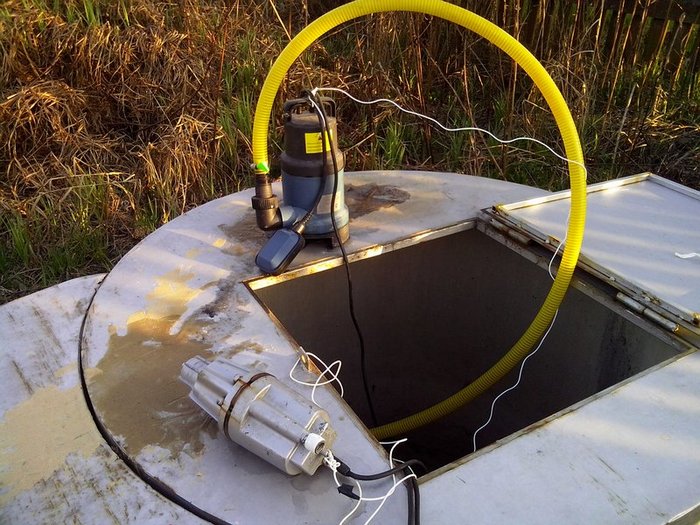
The unpretentiousness of these units allows them to be put into operation in different climatic conditions. No special maintenance or prevention is required. There are no rotating parts or moving mechanisms. The special optimized design of the pumps allows parts to wear out much less than other units. This solution will be beneficial for your dacha.
If the pump is not allowed to run idle, it will not overheat; the heat leaves instantly due to the cooling of the incoming water. Pumping alkaline water does not harm performance; mineral salts do not create sediment on the internal parts. Despite the exceptional reliability, weak sides They still have such devices.
The process of action itself, namely vibrations pumping liquid, can destroy the mechanism. Over time, they cause displacement of any parts, regardless of operating conditions. The part that comes out of the groove creates additional vibration and disrupts its own structure. Knowledge of the operating principle allows you to occasionally carry out preventive work. You should also exclude some conditions for work, namely:
- Do not use a submersible pump to pump water out of a newly dug well. Floating particles and dirt will very quickly clog the unit’s capacity; if you cannot do without this measure, you should clean the main components of the device.
- Do not use the submersible in large bodies of water such as rivers, lakes, or swamps.
- Do not supply water from a container with a limited supply of water, such as a cistern or tank.
- Do not use the pump as a device for pumping liquid out of a flooded room in your dacha.
If we consider the experience of using vibration pumps with wells, consumer reviews will vary. For some who have been using such pumps for decades, the entire operation process goes without problems. Some consumers instantly damage the pump itself and also destroy the well. Apparently, a whole set of factors is important here, which speaks about the quality of the pump and the well, but leaves no chance to predict the development of events.
Choosing a vibration pump for your garden
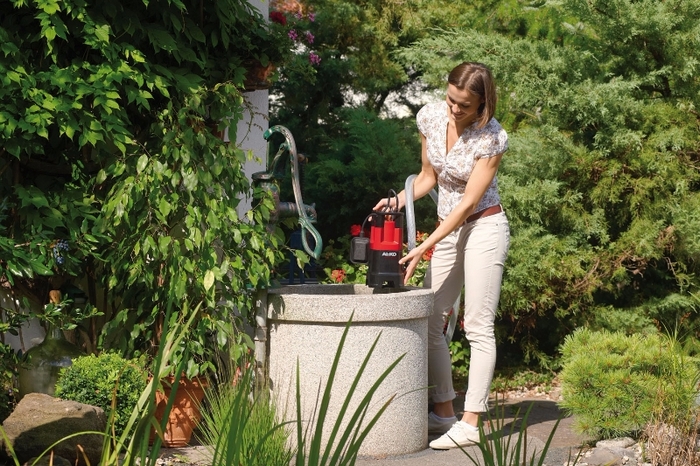
A variety of quality water pumps from the CIS countries, as well as from China, allows you to choose the optimal solution for your needs. Given the development of this sector, it is very difficult to find German and Italian water pump models, so, as a rule, there is nothing to say about them. Let's move on to a review of the most purchased and popular models on the market. By the way, the cost of a high-quality pump may not exceed 60-70 conventional units.
“Malysh” is the youngest in terms of characteristics, but the most popular model on the CIS market. A reliable water device, the most economical to purchase, can have two types of water intakes (upper and lower). Additional thermal protection allows the device to be resistant and durable in harsh winter conditions.
“Rucheek” - this water device is no less popular due to its powerful pressure. The characteristics differ slightly depending on the country of origin, but it gives stable pressure indicators of 60 meters.
“Aquarius” is a deep-well pump that costs more than other models, but its increased pressure characteristics (up to 100 m) and the ability to pump large volumes of water allow this unit to be used in large farms.
Pumping unit – main element any water supply. The efficiency and reliability of the entire system largely depends on the correctness of its choice.
For the construction of wells and wells, two types of pumps are used today - surface and submersible.
ABOUT existing varieties, technical parameters We will discuss the features of choosing submersible installations in our article.
Types and characteristics of submersible pumps
According to the principle of operation, submersible installations designed for pumping clean water, are divided into four categories:
- vibration;
- centrifugal;
- vortex;
- screw (screw).
The former are used to supply water from wells and boreholes dug in sandy soils. Their main advantages are reliability, simplicity of design and affordable price. Most Popular trade marks- “Little Stream” and “Baby”.
The principle of operation of the vibration pump is the interaction of the magnetic field of the coil with a steel rod on which a rubber diaphragm is mounted. Alternating current causes the rod to oscillate at a frequency of 50 Hz. They are transmitted to an elastic diaphragm, which creates a vacuum in the working chamber. Under its action, water from the source moves into the pump housing and is pushed out of it into the water supply pipe.
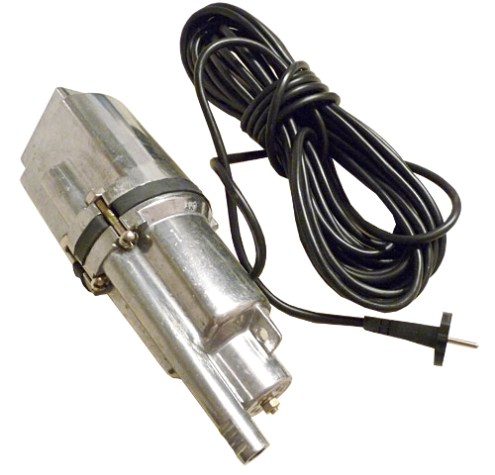
When choosing a submersible pump for a well or borehole, one should not forget about the advantages of centrifugal units. They are capable of lifting water from great depths, so they are used not only in wells, but also in artesian wells. The basis of such a pump is a wheel with blades mounted on an electric motor shaft. When it rotates, pressure is created in the housing, pushing water into the supply line.
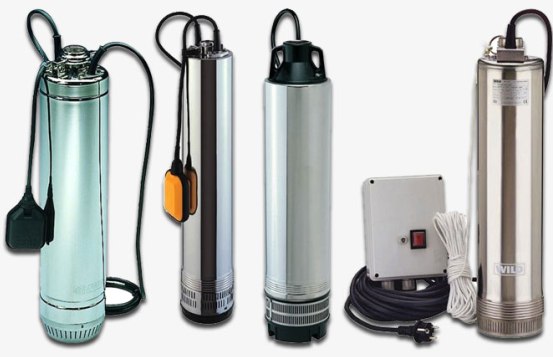
Submersible centrifugal pumps
Based on design features, single and multistage centrifugal pumps are distinguished. The number of lifting stages they have is equal to the number of impellers with blades. The more of them, the more powerful and productive the installation.
Vortex pumps are similar in principle to centrifugal pumps. They are used to lift fluid from deep wells.
The name of the screw pump speaks for itself. The main element of the installation is a screw (auger), the rotation of which creates pressure in the working chamber. Such pumps are installed in artesian wells and wells. They are characterized by high reliability and the ability to pump liquids with a large amount of abrasive particles (sand) without breakdowns.
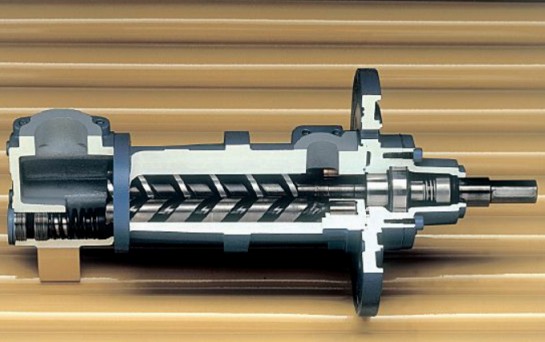
Water supply scheme using submersible pumps
For correct installation plumbing, you need to clearly understand what elements it consists of. Beginners in this matter will be helped by a connection diagram for a deep-well pump, which indicates their location and name.
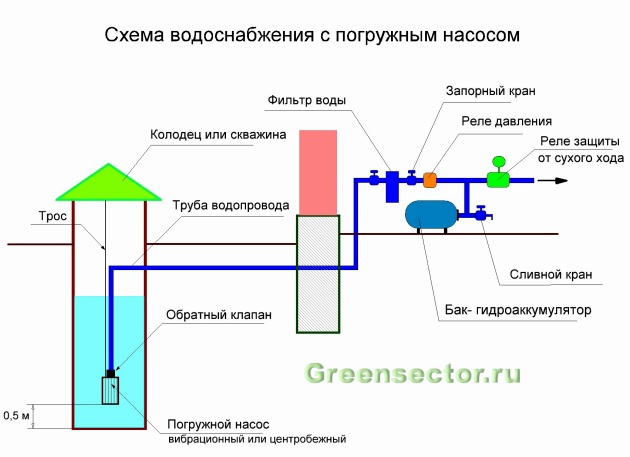
It should be noted that there is no fundamental difference in connecting vibration, centrifugal, screw and vortex pumps. All these units work in tandem with check valve, which is placed next to the pump or in front of the hydraulic storage tank.
Installing a deep-well pump does not require using a pressure switch in the water supply circuit. It is responsible for maintaining the pressure in the line within the limits specified by the user (or manufacturer).
The engine is protected from overheating (when the water level drops below the pump) by a dry-running relay mounted on the water pipe. It should be noted that the pump is a submersible type, equipped with float switch- “frog”, does not need to install such a relay. When the water level drops below its body, the protection is activated and turns off the engine.
A hydraulic accumulator tank is necessary for the operation of any pumping unit(both deep and superficial). This is a buffer element that reduces the frequency of pump activation, extending its service life. If the system does not have a hydraulic accumulator, the engine will turn on after each opening of the water tap and the pump will quickly fail. You can do without it only if a storage tank with a level sensor is installed in the attic of the house. Having pumped water into it, the pump turns off until the liquid is consumed to the level set by the user. After this, the sensor will give the pump a command to turn on and the cycle will repeat.
A drain valve on the main line is also necessary. Without it, you will not be able to free the pipes, boiler and storage tank from water to carry out repairs or preventive maintenance of the system.
In what cases is it beneficial to install a submersible pump, and in what cases is it beneficial to install a pumping station?
When getting ready, you need to decide the issue of choosing the type of pumping unit.
A surface station is the best option with the following initial water supply system data:
- The distance from the water source to the building is small (15-20 meters).
- The lifting height does not exceed 8-12 meters.
If the well or borehole is deep, and you need to reach the building at least 30 meters water pipe, then it is better to buy a powerful submersible pump. An important advantage of such a unit is its operational reliability and the absence of the need to insulate the pit (when installed in the yard).
Since the submersible pump is located in a well or well, the noise from its operation is not heard in the house. A pumping station, on the contrary, even when installed in a basement, needs good sound insulation.
There is one purely psychological moment that influences the choice pumping station other things being equal to the submersible pump, the supply conditions (pressure, productivity). This is a higher assembly readiness of the installation. A pump, a hydraulic accumulator, a pressure gauge, a pressure switch and a dry-running protection relay are mounted in one module. For a submersible pump, the main components are supplied separately, so it is not easy for beginners to assemble them into a single system.
Manufacturers have found a way out of this situation and offer customers household submersible units consisting of only two parts - a pump and an automation unit already connected to a hydraulic accumulator tank.
How to choose the right submersible pump?
If in the last century the dream of a summer resident was a “Baby” or “Rucheek” pump, today the market offers a huge assortment of submersible pumps.
At the same time, the installation selection algorithm remained unchanged and includes only two parameters:
- Pump capacity (m3/hour);
- Head (meters).
These two quantities are inversely proportional to each other. This means that what greater productivity the installation develops, the smaller the depth it can raise water from.
For illustration this fact We suggest studying Table No. 1, which shows the relationship between the main parameters of the pump.
In the pump passport, the manufacturer indicates two extreme values: maximum flow (performance) and maximum pressure. Therefore, when buying a pump with a pressure of 85 meters, remember that with such a rise, its supply to the water supply will be zero. The actual performance characteristics of the unit are in the middle. They are the ones that should be taken into account when studying passport data.
Let's answer the question together, which submersible pump is better to choose, based on the data in table No. 1. Let’s assume that the lift height in the well (or borehole) is 8 meters (6 meters to the water surface + 2 meters to submerge the pump). The distance to the house is 30 meters, the height of water rise in the house (to the second floor) is 5 meters.
Loss of pressure at horizontal section For simplicity, the water supply is assumed to be 1 meter per 10 meters of pipe length.
Another value that must be taken into account is the pressure loss to overcome filters, tees and pipe turns. You can accurately calculate it using special tables. We will approximately take this value equal to 10% of the pressure.
Water should enter the accumulator under pressure from 1.5 to 3.0 atmospheres (bar). To do this, you will additionally need from 15 to 30 meters of pump pressure (for calculation we take 20 meters).
The final figure will look like this:
- Vertical lift – 8+5=13 m.
- Horizontal feed – 30 m x 0.1 = 3 m.
- Creation of pressure in the system – 20 m.
Total: 13+3+20= 36 m + 36 x 0.10 (for losses) = 40 meters of pressure.
In our table, this pressure approximately corresponds to a pump performance of 0.55 m3/hour. Is it a lot or a little? It is quite enough for a family of 2-3 people. A larger number of residents will require a more productive installation.
The everyday principle of “buy with reserve” when choosing a pump is only partially justified. If you buy a unit whose pressure is 20-25% higher than designed, this is normal. If it exceeds it by 2 times, then you will definitely overpay.
Popular brands and approximate prices
When choosing a deep-well pump, every person strives to buy a product that is not too expensive, but as reliable as possible.
The German brand Grundfos, as well as the Italian Pedrollo and Dab, received high user ratings. Their pumps are distinguished by high build quality and reliable operation.
Anyone who is not short of money prefers to buy a submersible pump for a well with automation from one of the indicated brands. Estimated prices for units of average productivity (3 m3/hour) and pressure (70 meters) here range from 25 to 60 thousand rubles.
![]()
Models of units designed for wells in the middle price range are slightly cheaper from 17 to 30 thousand rubles.
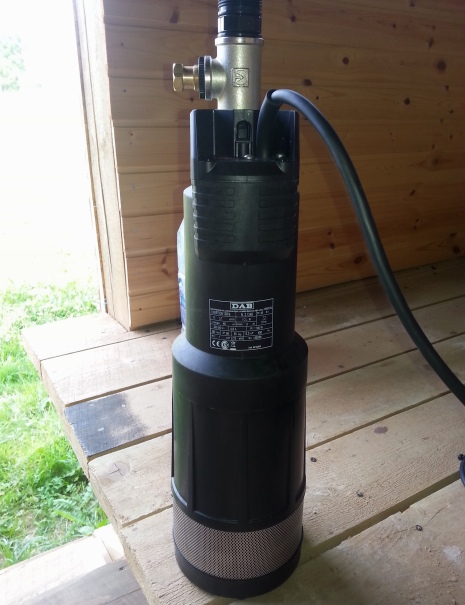
Price submersible pumps for wells and wells of domestic manufacturers Belamos, Aquarius, Caliber and Gilex is more affordable. The price is the most simple models for water supply from a well starts from 2 thousand rubles. Downhole units cost on average from 9 to 18 thousand rubles.
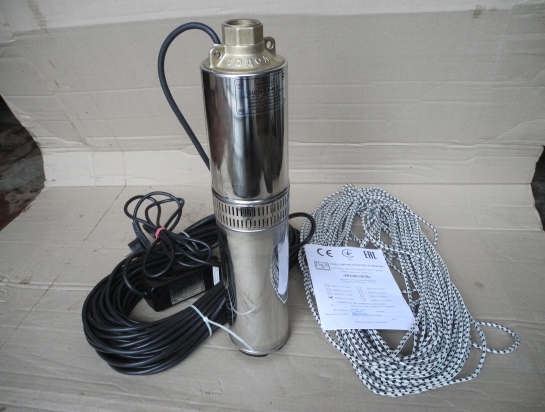
AQUARIUS BCPE 0.5 - 40 U
Popular among summer residents, vibration-type pumps “Rucheek” and “Malysh” occupy the lowest price group, despite their good performance. You can purchase such equipment at a price from 1,600 to 2,800 rubles.
IN country houses The water supply system often depends on a well or borehole, which is installed at a depth of 8-10 meters. It is not possible to get water from such a depth on your own. Moreover, it is inconvenient to go outside every time you need fresh drinking water. Therefore, owners of country houses and country houses should pay special attention to models of submersible devices. They will ensure uninterrupted water supply to your home. Let's look at how to choose submersible pumps for wells and the principle of operation of the mechanism.
What does a submersible pump look like?
A submersible pump operates in water. It lifts liquid even from very deep wells and wells to the surface. It is worth distinguishing between well and borehole devices. Boreholes, as a rule, have a more elongated shape for working in narrow wells and a higher pressure for lifting water from great depths.
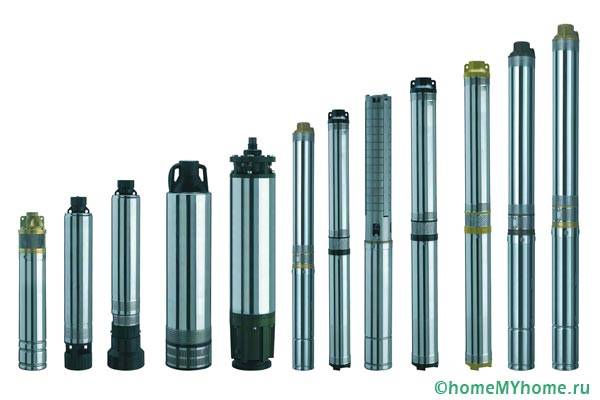
These types have minor differences in design. Basically, all units consist of the following parts:
- The impeller, which is the main structural element. It sets in motion all other parts of the structure;
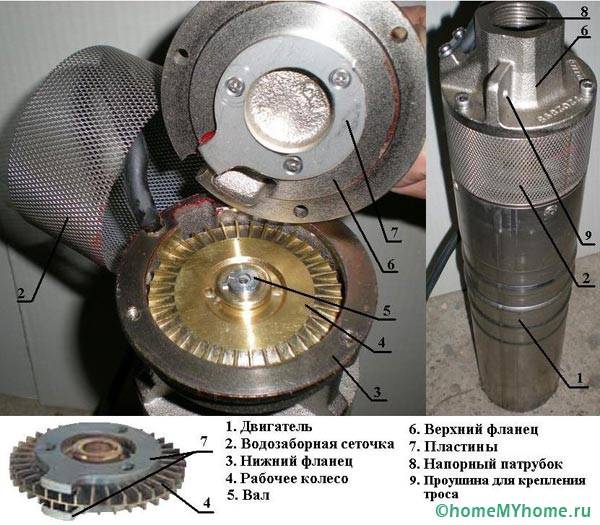
Impeller of the device
- Wheel blades. They generate centrifugal force, which is necessary for the rapid absorption of water;
- Suction area;
- Impeller housing. He protects him from negative influence environment;
- Valve - retains water in the pump and prevents it from flowing back into the well;
- A protective mesh is necessary to protect drinking water from harmful impurities that can negatively affect the health of the residents of the house.
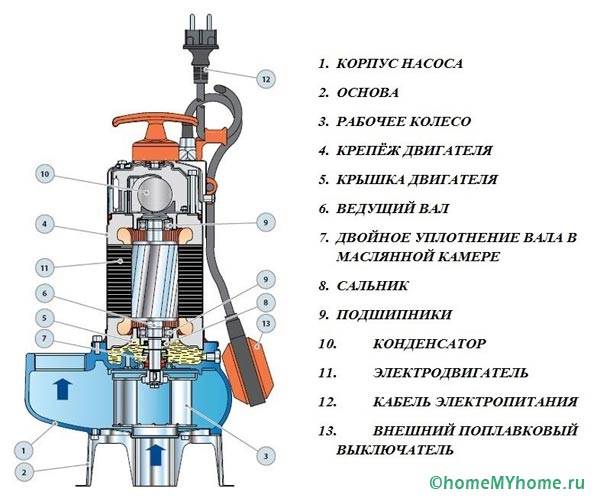
Submersible unit design
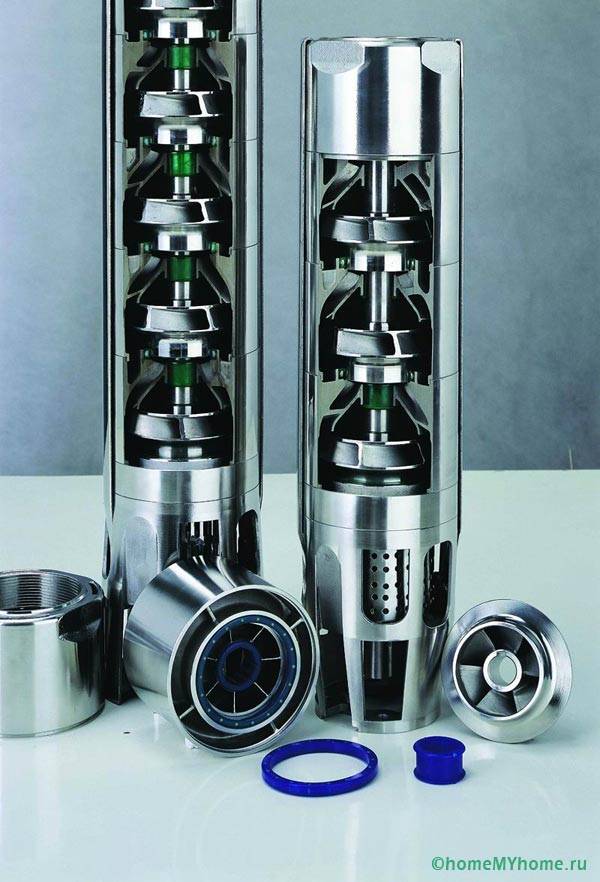
Sectional view of the device
A submersible blower operates using electricity. It causes the impeller to rotate. Thus, the liquid flows from the well or well into the pipeline, which, in turn, conducts water to the plumbing system.
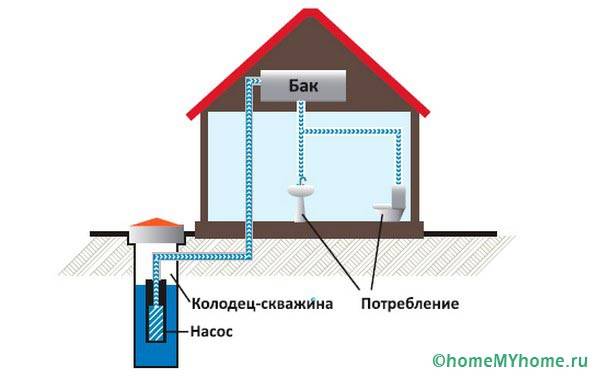
As we can see, the principle of operation, as well as the design of the supercharger itself, are elementary. Now let's find out what types of these devices exist and how to choose a submersible pump for a well.
Video: operating principle and design of a submersible pump
Classification of submersible units
According to design, the following types are distinguished:
- Vibrating– is a structure consisting of a vibrator, an electromagnet and a housing. Widely used in summer cottages not only for pumping and delivering water to the house, but also for the garden. Vibration devices show good performance in terms of pressure and power. At the same time, their price is low;
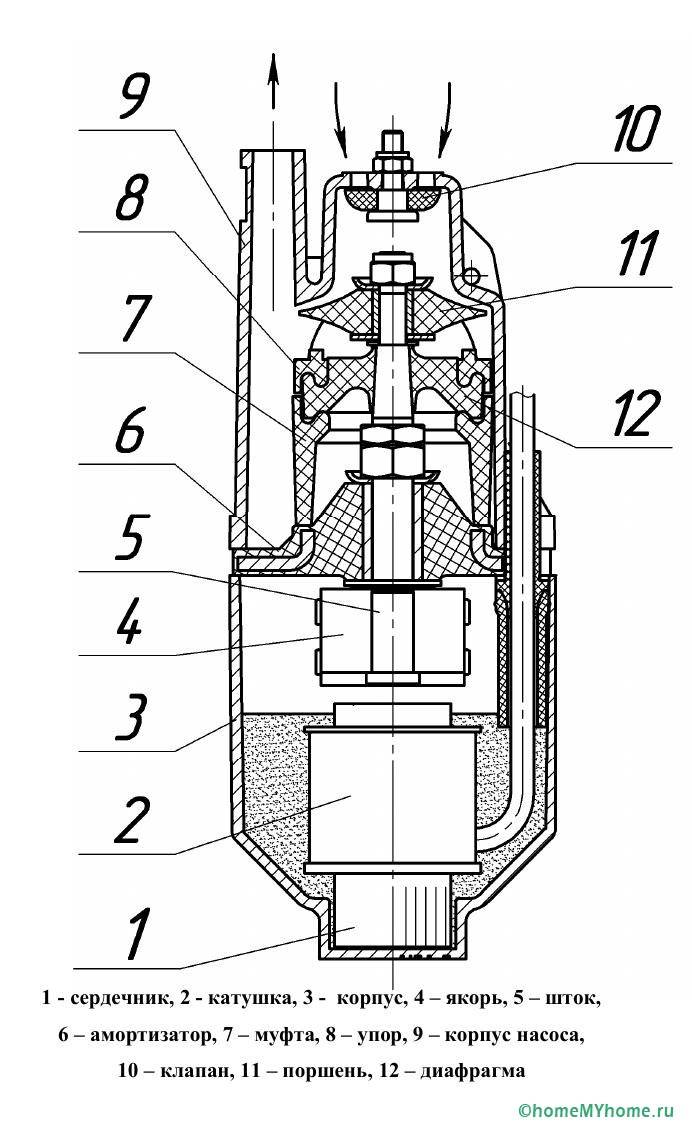
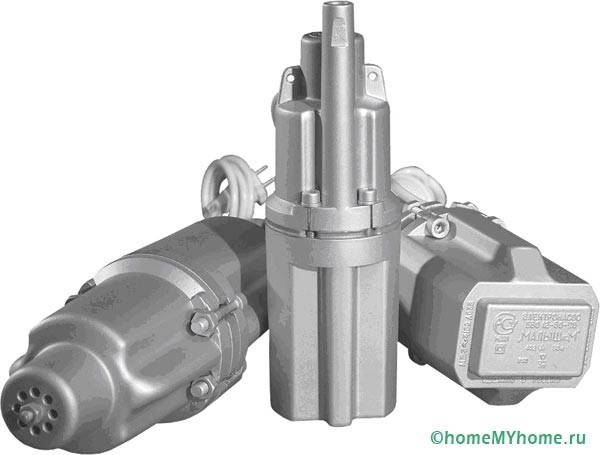
- Vortex– consists of a discharge area and an electric motor. The first element is used to pump liquid, the second is used to supply water to the house. This type is capable of lifting water from a depth of 12 meters. In this case, the process occurs quite quickly;
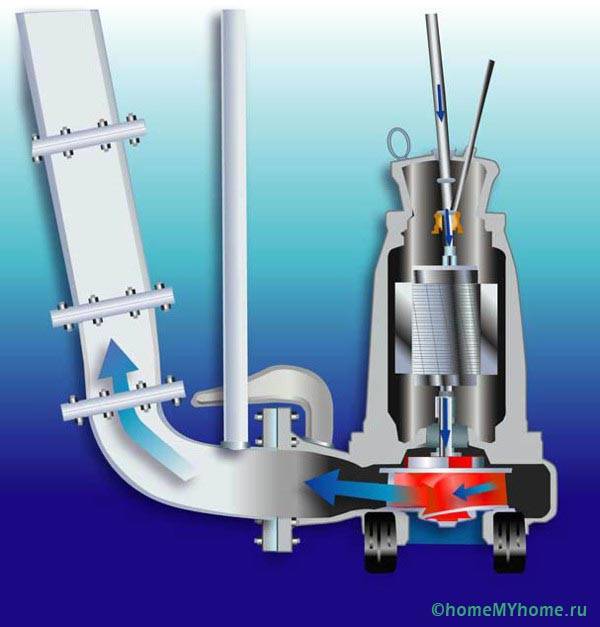
Operating principle of a vortex type device
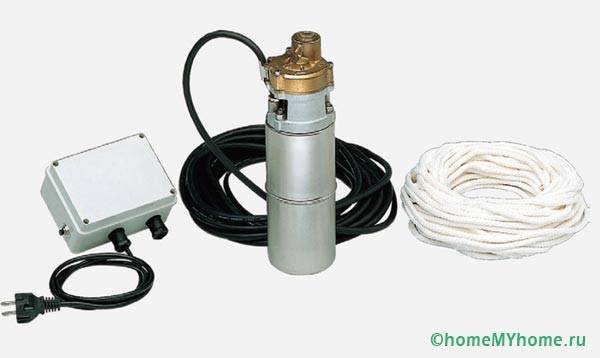
Vortex unit
- Centrifugal– a complex of two blocks: a working chamber and an engine. They pump out up to several hundred liters per hour thanks to the presence of a special centrifugal shaft. However, such devices have one significant drawback: they consume too much.
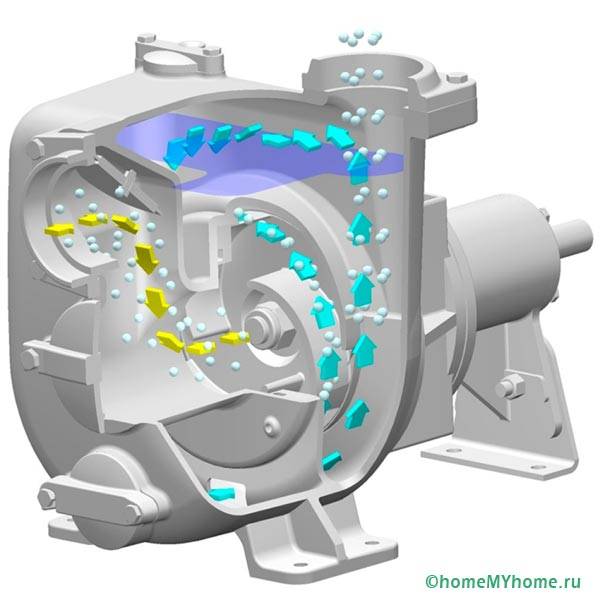
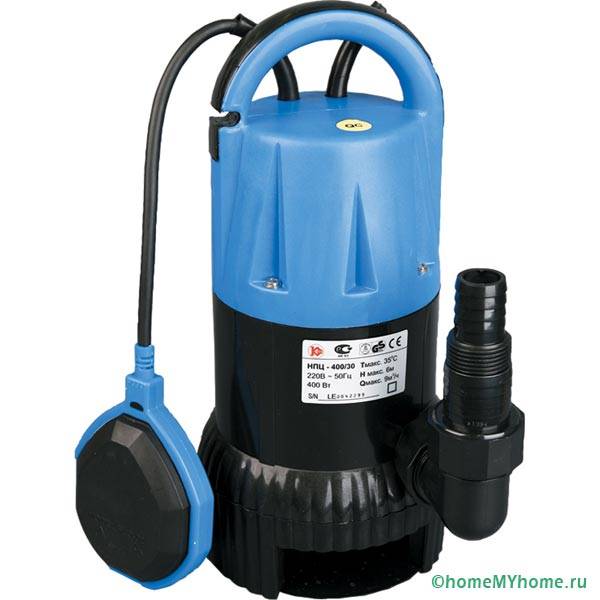
Centrifugal unit
Criteria for selecting submersible devices
To make the device suitable for your home, you should decide on the following parameters:
- Distance from well to home. The greater the distance, the more powerful the pump model should be chosen;
- Volume of water consumed. As practice shows, for ordinary families consisting of 4-5 people, the most ordinary blower of medium power is suitable. But if more people live in the house, it is worth choosing a stronger model;
- Performance. This parameter measured in liters of liquid that the pump can lift per unit of time. On average, productivity reaches 4.2÷4.5 cubic meters. However, if the device is necessary not only for the usual water supply of a home, but also for watering a spacious personal plot, then you should pay attention to models with a capacity of 4.8 cubic meters and above;
- Power. Indicated in kilowatts. This indicator indicates the volume of water supplied per unit of time. But you should not buy a device according to the principle “the more power, the better.” If your family does not need too much water, then go for a blower with a medium wattage, as a unit that is too powerful will consume a lot of energy.
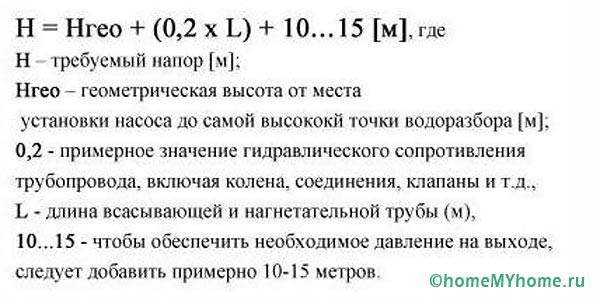
Based on these indicators, you will select the optimal unit for your home, which will serve you for many years in a row.
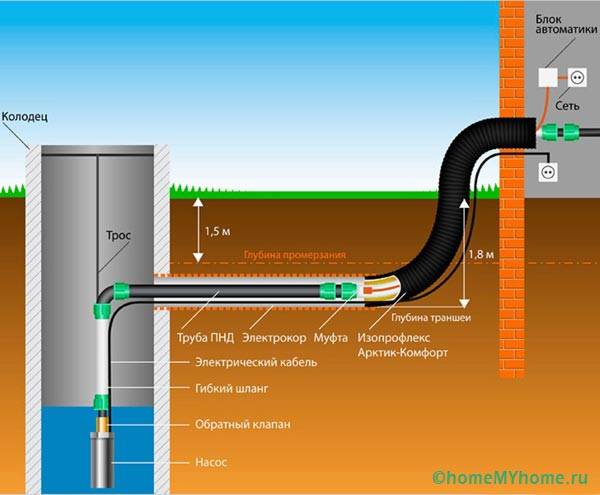
Which pump to choose for a well: review of popular models
Video: Grundfoss well pumps
If you do not know which submersible pump to choose for your well, check out the table below:
Brand name | Description | Who should buy |
"Pedrollo" | Quality device from Italian manufacturer. The case is made of stainless steel, thanks to which the service life of the device reaches tens of years. There are no models with a diameter of “3”. | - For those who want to install a high-quality imported pump for an adequate amount. |
"Grundfoss" | German-Danish brand. Exist additional functions, such as “dry running protection” and “soft start”. | - For those who are willing to pay a lot of money for quality.- For those who need a unit with a diameter of “4”. |
"Sprut" | Ukrainian-Chinese production. The products contain pumps with a diameter of “3”. Low price. | - For those who want to equip a small country cottage area where high pump power is not needed. |
"ECV" | Ukrainian production. In comparison with European manufacturers, it has a low cost and, nevertheless, high performance. However, at the same time, such models consume an unreasonable amount of electricity. | - For those who want to equip rural production enterprises. |

Products from Pedrollo
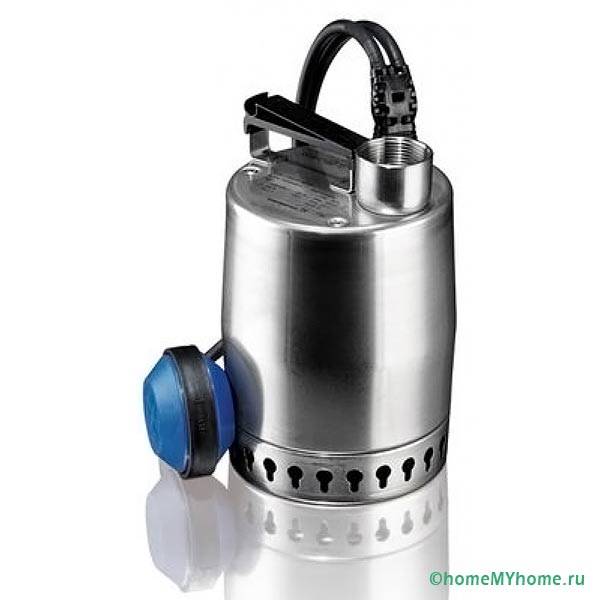
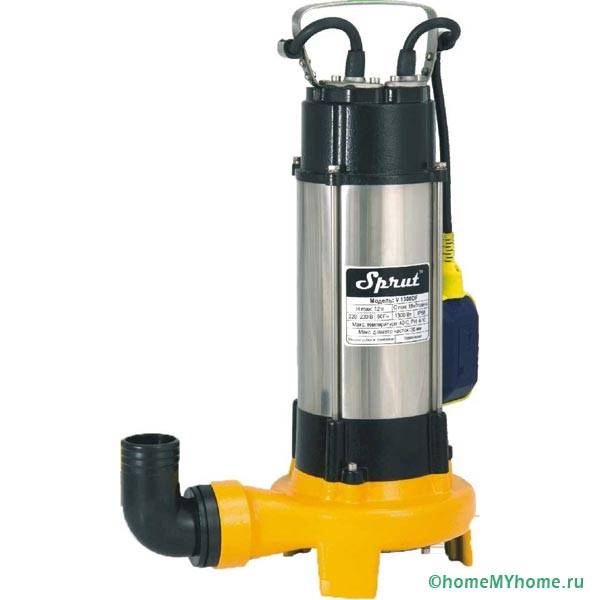
Sprut devices
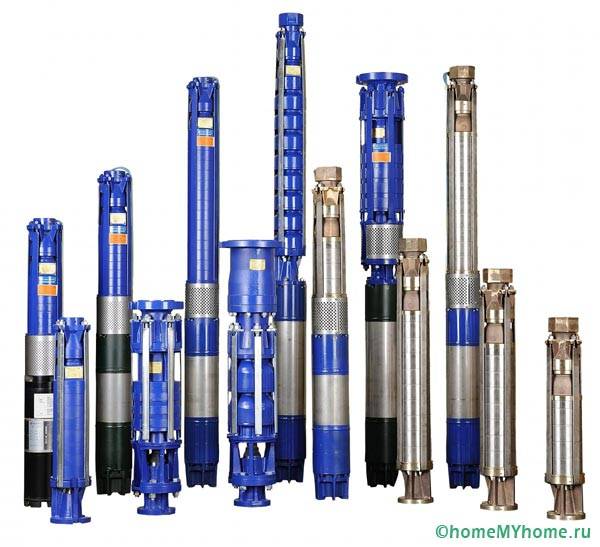
Deep blowers ECV
This plate will guide you on which pump to choose for a well or well.
conclusions
- A submersible pump is a necessary device for summer cottages, where the main source of liquid is a well;
- The unit conducts water from a depth of more than 10 meters;
- The more water you need, the greater the power should be.
Video: how to choose a pump and what types there are
You might also be interested in:
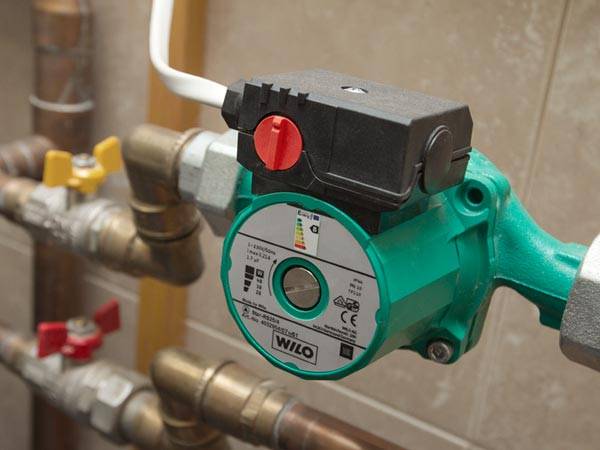 Circulation pumps for heating private houses
Circulation pumps for heating private houses


